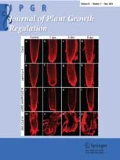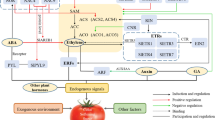Abstract
The gibberellin (GA) content of the reproductive organs ofCitrus sinensis (L.) Osb., cv. Bianca Comuna and the seedless variety, Salustiana, were examined by combined gas chromatography-mass spectrometry (GC/MS) at different stages of development. Gibberellins A1, A20, and A29 were identified in the reproductive buds of both cultivars 21 days prior to anthesis and in fruits 35 days after anthesis by comparison of their mass spectra and Kovats retention indices with those of standards. In addition, three uncharacterized isomers of GA1 were detected, one in buds and two in fruits. The presence of GA4 in both tissues, and of GA8 in the reproductive buds, was indicated by the occurrence of characteristic ions at the expected retention times, although their spectra were too weak for full identification. Vegetative shoots of cv. Salustiana contained gibberellins A1, A19, A20, and A29, and the unidentified isomer of GA1 present in reproductive buds. The presence of trace amounts of gibberellins A8 and A17 was also indicated. Although the two varieties did not differ qualitatively in the GAs present during flower and fruit development, the seedless variety contained slightly greater amounts. The concentrations of gibberellins A1, A4, and A20 were determined by gas chromatography-selected ion monitoring (GC/SIM) throughout ovary development and early fruit growth. In both varieties, the maximum GA1 concentration occurred at anthesis. Highest concentrations of gibberellins A20 and A4 were found in fruit 35 days after anthesis, although the GA1 concentration at this stage remained low.
Similar content being viewed by others
References
Bain JM (1958) Morphological, anatomical, and physiological changes in developing fruit of the Valencia orange,Citrus sinensis (L.) Osbeck. Aust J Bot 6:1–24
Bohner J, Hedden P, Bora-Haber E, Bangerth F (1988) Identification and quantitation of gibberellins in fruits ofLycopersicon esculentum, and their relationship to fruit size inL. esculentum andL. pimpinellifolium. Physiol Plant 73:348–353
Frost HB, Soost RK (1968) Seed reproduction: Development of gametes and embryos. In: Reuther W, Batchelor LD, Webber HJ (eds) The citrus industry, vol. 2. University of California Press, Berkeley, pp 290–324
Garcia-Martinez JL, Sponsel VM, Gaskin P (1987) Gibberellins in developing fruits ofPisum sativum cv. Alaska: Studies on their role in pod growth and seed development. Planta 170:130–137
Garcia-Papi MA, Garcia-Martinez JL (1984) Endogenous plant growth substance content in young fruits of seeded and seedless Clementine mandarin as related to fruit set and development. Sci Hortic 22:265–274
Gaskin P, MacMillan J, Firn RD, Pryce RJ (1971) “Parafilm”: A convenient source of n-alkane standards for the determination of gas Chromatographic retention indices. Phytochemistry 10:1155–1157
Gil GF, Martin GC, Griggs WH (1972) Fruit set and development in the pear: Extractable endogenous hormones in parthenocarpic and seeded fruits. J Am Soc Hortic Sci 97:731–735
Goldschmidt EE (1976) Endogenous growth substances of citrus tissues. HortScience 11:95–99
Goodwin (1978) Phytohormones and fruit growth. In: Lethem DS, Goodwin PB, Higgins TJV (eds) Phytohormones and related compounds: A comprehensive treatise II. Elsevier/North-Holland Biomedical Press, Amsterdam, pp 175–213
Hedden P (1987) Gibberellins. In: Rivier L, Crozier A (eds) Principles and practice of plant growth substance analysis, vol. 1. Academic Press, London, pp 9–110
Ito H, Motomura Y, Konno Y, Hatayama T (1969) Exogenous gibberellins are responsible for the seedless berry development of grapes. I. Physiological studies on the development of seedless Delaware grapes. Tohoku J Agric Res 20:1–18
Iwahori S, Weaver RJ, Pool RM (1968) Gibberellin-like activity in berries of seeded and seedless tokay grapes. Plant Physiol 43:333–337
Jones RL, Varner JE (1967) The bioassay of gibberellins. Planta 72:155–161
Kawarada A, Sumiki Y (1959) The occurrence of gibberellin A1 in water sprouts of citrus. Bul Agr Chem Soc Japan 23:343–344
Khalifah RA, Lewis LN, Coggins CW Jr (1965) Isolation and properties of gibberellin-like substances from citrus fruits. Plant Physiol 40:441–445
Kuraoka T, Iwasaki K, Ishii T (1977) Effects of GA3 on puffing and levels of GA-like substances and ABA in the peel of Satsuma mandarin (Citrus unshiu Marc). J Am Soc Hortic Sci 102:651–654
Martin GC (1971) Gibberellin estimation by an adaptation on the dwarf rice bioassay. HortScience 6:536–538
Martin GC, Horgan R, Nishijima C (1982) Changes in hormone content of pear receptacles from anthesis to shortly after fertilization as affected by pollination or GA3 treatment. J Am Soc Hortic Sci 107:479–482
Moore PH, Pharis RP, Koshioka M (1986) Gibberellins in apical shoot meristems of flowering and vegetative sugarcane. J Plant Growth Regul 5:101–109
Pharis RP, King RW (1985) Gibberellins and reproductive development in seed plants. Annu Rev Plant Physiol 36:517–568
Poling SM, Maier VP (1988) Identification of endogenous gibberellins in Navel orange shoots. Plant Physiol 88:639–642
Powell AA, Krezdorn AH (1977) Influence of fruit-setting treatment on translocation of14C-metabolites in citrus during flowering and fruiting. J Am Soc Hortic Sci 102:709–714
Soost RK, Burnett RH (1961) Effects of gibberellin on yield and fruit characteristics of Clementine mandarin. Proc Am Soc Hortic Sci 77:194–201
Wiltbank WJ, Krezdorn AH (1969) Determination of gibberellin in ovaries and young fruits of Navel oranges and their correlation with fruit growth. J Am Soc Hortic Sci 94:195–201
Author information
Authors and Affiliations
Rights and permissions
About this article
Cite this article
Talón, M., Hedden, P. & Primo-Millo, E. Gibberellins inCitrus sinensis: A comparison between seeded and seedless varieties. J Plant Growth Regul 9, 201–206 (1990). https://doi.org/10.1007/BF02041963
Received:
Accepted:
Issue Date:
DOI: https://doi.org/10.1007/BF02041963




